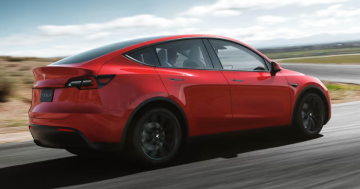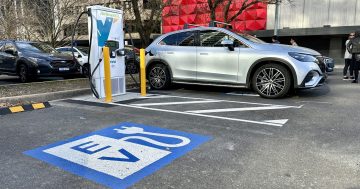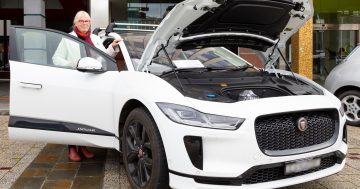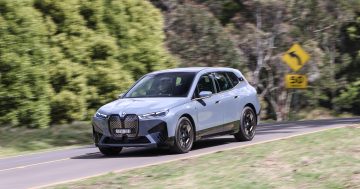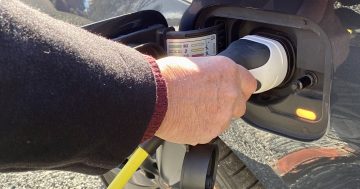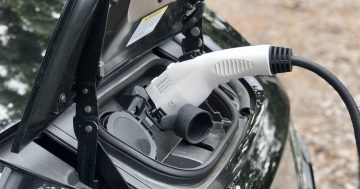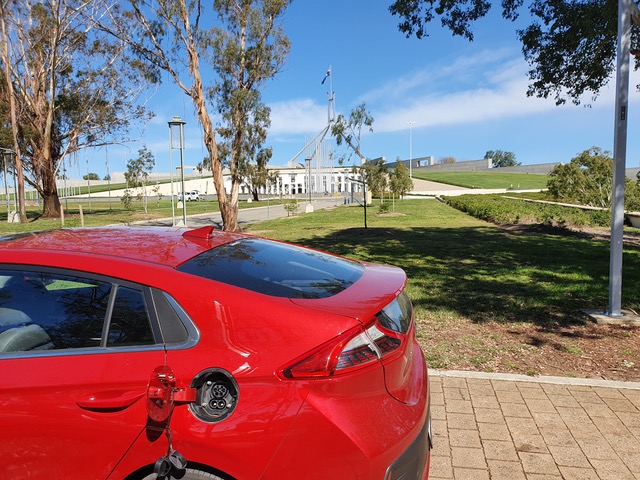
An electric Hyundai Ioniq outside Parliament House. Photo: Supplied.
Hordes of electric vehicles will descend on Canberra’s CBD tomorrow (9 September) in celebration of the first World EV Day.
All manner of Teslas, a Hyundai Kona with a camper trailer, a converted Porsche 986, bikes, scooters and more will be on display along the middle of Northbourne Avenue from 10:00 am. A few hours later, they’ll form a convoy and circle around Parliament House before pulling up at the flags on Queen Elizabeth Terrace.
The date was set just over a month ago as a global social-media campaign aimed at “engaging consumers around the sustainability benefits of EVs”.
Leading the charge is the ACT Branch of the Australian Electric Vehicle Association (AEVA). This group of passionate EV owners first came together in 1986 to end the century-long reign of fossil-fuel-powered transport.
Events Coordinator for AEVA ACT Adele Craven hopes World EV Day will be hard to miss from the Legislative Assembly, especially as an election brews and caretaker mode kicks in two days later.
“The day itself will be informal but we are inviting local and federal ministers and public servants. I am still working on trying to get the Transport Canberra bus on-site, at least for part of the day,” she says.
She’d like to see additional incentives put in place that may tip more Canberrans over to the EV side.
As of the 1 August this year, there were a total of 687 electric vehicles on ACT roads. The best-sellers are the Tesla Model 3, the Kyburz postie bike and the Nissan Leaf. There are over 4,000 hybrids in the ACT, most of which are Toyotas.
In addition to lower running costs, financial advantages for EV buyers include not having to pay stamp duty on their new purchase and a 20 per cent discount on registration costs. They are also allowed to drive in transit lanes, which Mrs Craven concedes isn’t all that earth-shattering given as there is only one in the ACT, on Adelaide Avenue.
“With ACT achieving 100% renewable electricity, transport is now the highest-emitting sector. Any adoption of electric vehicles in any form will help to reduce emissions. We aim to robustly support the Net Zero Emissions by 2045 goal.”
The ACT Government presented the Transition to Zero Emissions Vehicles Action Plan in 2018 and has also signed up to four different declarations and agreements around the world. It all fits into the broader ACT Climate Strategy and a suite of measures designed to encourage greater use of walking, bicycles and public transport.
The shove is working as Canberra has among the best charging infrastructure in the country.
“Part of our goal in running events is to make EVs more visible to federal politicians,” Mrs Craven says.
However, there is no getting around the fact that EVs remain more expensive off-the-shelf than their ‘EVil’ counterparts.
As with anything else with batteries, they also go flat and wear out. The technology is improving in leaps and bounds such that the modern battery pack should easily last about 10 years, but it does still take an average of eight hours to fully charge an electric car using a home socket*.
Every month, AEVA ACT has also been faithfully running ‘EV Experience Days’ at the Capital Brewing Company in Fyshwick. Members of the public can turn up, be taken for a ride in a Tesla or Hyundai, and then have a beer to boot.
Mrs Craven adds that for the March event next year, dozens of local organisations, businesses and government agencies are supporting their major event – the ‘Zero Emissions EVenture’.
“It will be an ‘amazing race’ style event during which teams use a range of different modes of electrified transport to get their way across Canberra with challenges in between.
“The event will demonstrate the fact that we have depended on various forms of electric mobility for decades, and highlight the current development and potential of technology around EVs.”
*CORRECTION: This article originally stated that “it does still take an average of eight hours to fully charge an electric car”. This has been updated to reflect that an eight-hour charge is from a household socket.













